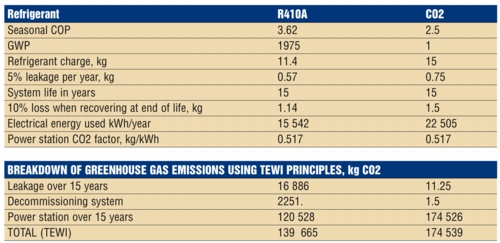GWP versus TEWI — do headline figures miss the point?

The building industry is doing everything it can to reduce emissions of greenhouse gases. To make rational decisions about which refrigerants to use, it is vital to have accurate information. However, headline statistics on global-warming potential can be misleading. Simon Keel of Daikin UK explains.
The old riddle asks, ‘Which is heavier — a pound of lead or a pound of feathers?’ Obviously the answer is in the weight not the composition of the material. This adage is also true for the use of refrigerants in air-conditioning systems and carbon emissions. Headline statistics say that refrigerants with a high global-warming potential (GWP) used in the provision of renewable energy by heat pump systems outweigh the benefit of the carbon-dioxide savings they achieve.
But probably the best way to reduce emissions is to use highly efficient equipment that minimises the use of energy, thus reducing the consumption of fossil fuels. The problem is that very often that same equipment is driven by a refrigerant which, volume for volume, is thousands of times worse for the atmosphere than CO2. Worse still, this refrigerant may leak out of these systems at an rate estimated to being between 5% and 10% per annum, average to extreme. There is also a small leakage during installation and decommissioning.
It would be bad science to condemn this system out of hand and install an alternative that uses refrigerant with a very low GWP without a close look at the two. Unfortunately this is exactly what is happening in many cases. There are specifications written for, and environmental credits given to, just such scenarios. It seems the headline properties are the only ones that matter.
This is this is not only bad science, it is also misguided, as the warm feeling that one has done the best for the planet may be totally misplaced. This can and should be checked before any decision is made.
There is a British Standard/European Committee for Standardisation regulation which contains a formula for calculating this. It is known as BE EN 378-1 Annex B and is called total equivalent warming impact or TEWI. It looks at all the factors involved with an installation and works out the total quantity of greenhouse gases or their equivalents that are released over a period of time. That period can be put into the formula.
Two types of impact that are considered, direct and indirect. The direct impacts are items like refrigerant properties and greenhouse gasses released, for example, from insulation. Indirect global-warming impacts cover any CO2 released by electricity generation and transmission.
To be able complete the calculation, certain other facts must be entered into the equation. These are the type, installed volume and GWP of the refrigerant, as well as a subjective figure equating to the percentage of the refrigerant that is likely to leak per year. For small, well installed systems the leakage may be a very small quantity but may be high as an overall percentage; for larger multi indoor systems such as VRF, the opposite may be true.
One of the most important inputs reflects the efficiency of the system, which is converted to energy usage over the operating life of the system. For an air-conditioning system, the answer lies in the energy efficiency ratio (EER); the higher figure, the better the efficiency. Then there is the carbon factor of the fossil fuel being used. This can be taken from the Building Regulations Part L list which is the best UK standard.

Add in to the recovery/recycling factor, and a calculation can be made which gives the total carbon-dioxide-equivalent emission for the plant during its operating life.
As it is a mathematical calculation, it only reflects the facts that have been entered. It has no preference about one system or refrigerant over another. In other words whether it is dealing with lead or feathers matters not, it is only the total weight that is of significance.
Thus adding the direct effect in carbon terms of any projected leakage using R410A to its far more efficient indirect emissions may well result in far less damage to the planet (TEWI) than using a low GWP refrigerant such as CO2, which is nowhere as efficient and emits far more carbon dioxide at power stations during its operation.
The equation can also be used for heating comparisons. Comparing a gas boiler with a heat pump can also demonstrate the effectiveness of using renewable heat produced by a reverse-cycle system which is over 300% efficient rather than burning fossil fuel in a direct system which is about 90% efficient.
The whole point is that looking at headline figures in isolation is misleading. Organisations that are actively engaged in promoting sustainable solutions or advertising themselves as low-carbon users are doing so in a misguided manner if they fail to take the long and entire view.
Simon Keel is with Daikin UK.








